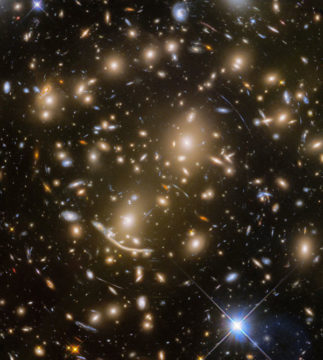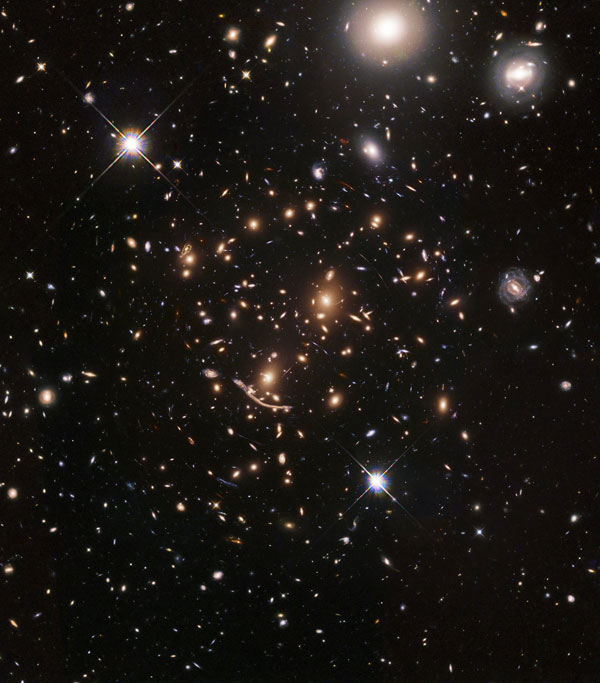Starbirth and stardeath light up a nearby galaxy while faraway galaxies twist and bend in these new images from NASA's Hubble and Chandra space observatories.
This Ring Galaxy Sparkles in X-rays
Long ago two galaxies hit each other head on, the smaller galaxy passing through the larger one like a bullet. The shock wave triggered by the bullet galaxy billowed outward, sparking stellar fireworks in an expanding ring. Stardeath accompanied this burst of formation, as short-lived massive stars collapsed into neutron stars and black holes. And with stardeath, ironically, came light — or more specifically, X-rays. Astronomers think some of these massive stellar cinders now feed on companion stars at fantastic rates to power the seven ultraluminous X-ray sources dotting the galactic ring below.

X-ray: NASA / CXC / INAF / A. Wolter et al; Optical: NASA / STScI
This image is part of a larger study appearing in the Astrophysical Journal that focused on seven such ring-shaped galaxies. Ring galaxies only represent up to 0.2% of the population, but they're such fascinating aberrations that Anna Wolter (Astronomical Observatory of Brera) and collaborators set out to collect all of those observed by the Chandra X-ray Observatory. The resulting sample contains a total of 50 ultraluminous X-ray sources.
What powers these sources remains unclear, but Wolter and collaborators favor the idea that they're either neutron stars or black holes gobbling down gas grabbed from companion stars. A competing theory suggests that they might be much heftier black holes, with between 100 and 1,000 Suns' worth of mass, but dining at a more delicate pace. Larger samples of these mysteriously bright objects will help astronomers understand their nature and origin.
Hubble Widens Its View on Galaxy-rich Clusters

NASA / ESA / J. Lotz / HFF Team (STScI)
Between 2013 and 2016, a big chunk of the Hubble Space Telescope's time went toward peeling back the veil of time. Hubble took on the huge Frontier Fields project to image six massive galaxy clusters, using their immense gravitational power as cosmic lenses to peer back to the earliest galaxies at cosmic dawn. Contributing Editor Govert Schilling covered this ambitious project in the June 2014 issue of Sky & Telescope.
Now, Hubble is back at it, undertaking a new project called Beyond Ultra-deep Frontier Fields And Legacy Observations (BUFFALO). Hubble's view is typically deep but narrow, so this project returns to the same six clusters with the aim of widening the view. The BUFFALO project will have four times the area of Frontier Fields to help astronomers better map out the distribution of matter (dark and ordinary) in these clusters, which in turn enables astronomers to better understand the distant galaxies whose light is magnified and distorted by the foreground cluster.
To start off the BUFFALO project, Hubble is returning to the last field it imaged as part of Frontier Fields, the massive cluster Abell 370.

NASA / ESA / A. Koekemoer (STScI) / M. Jauzac (Durham Univ.) / C. Steinhardt (Niels Bohr Institute) / BUFFALO team
In addition to new Hubble imagery, BUFFALO will also make use of existing observations from other space telescopes, including ultra-deep Spitzer Space Telescope observations, to better understand the cosmic history of these clusters.
 0
0









Comments
You must be logged in to post a comment.